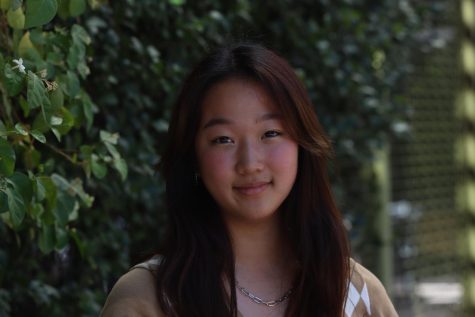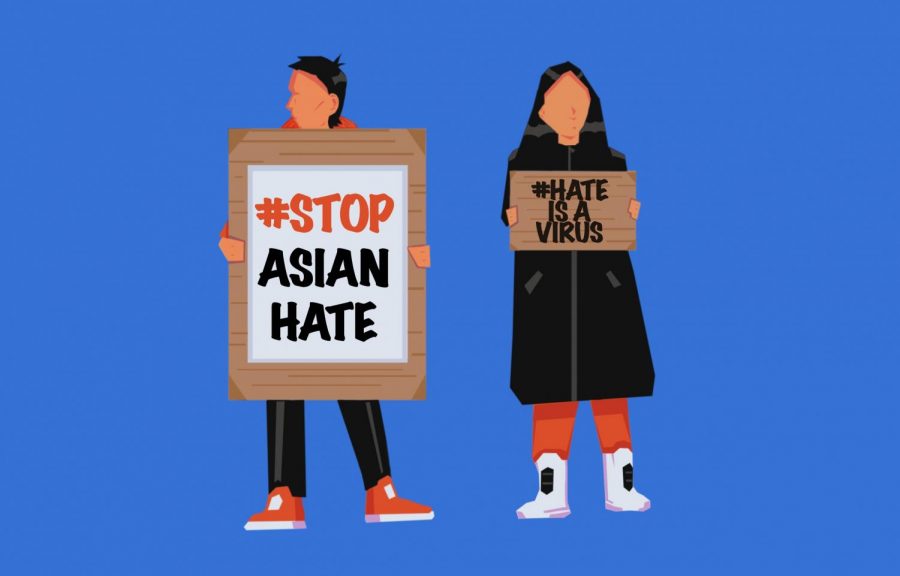The Normalization of Hate
Two protesters drawn with signs reading #stopasianhate and #hateisavirus, trending social media hashtags on the topic of violence towards Asian Americans.
“Ching chong nee how ma!!”
The words were terse and scornful. The empty park echoed these slings, and my face burned as I looked over at my brother, hoping I had misheard. The bewildered expression on his face confirmed that I hadn’t, and we both turned towards the source of the name-calling. We were in Southern Croatia and my brother and I, bored with the hotel’s bad wifi, had decided to explore the park across the street.
As the more assertive sibling, I retorted with a “Hey, screw you! Are you kidding me?”
The teenage boys who spewed the slurs suddenly slinked away, trying to leave the park without further conflict. Perhaps the fact that we weren’t Chinese tourists, but rather Americans, had scared them off. Nevertheless, my clenched fist and tightened shoulders loosened up, letting relief shower over me. I desperately wanted for us to disappear, to avoid any further confrontation and embarrassment, but my annoyance hung on me like a wet T-shirt on a humid day, as we hurriedly returned back to safety, otherwise known as the Sheraton.
We recounted the story to our parents, but they shrugged the incident off as a byproduct of Southeastern Europeans’ limited exposure to people of Asian ancestry. We’re foreigners, we were told. Don’t take it personally, and be grateful you live in the wonderful diversity of the Bay Area where differences are enthusiastically embraced. Sadly, that notion seems to have been a dream, turned into a gruesome nightmare.
Former President Donald Trump pierced that fleeting veil when he first coined COVID-19 as the “Chinese virus” or the “Kung-flu.” Because the virus was first identified in Wuhan, China, many people around the world began placing virus blame on the Chinese. In response, Asian Americans, by virtue of our skin color, seem to have been swept up in this misinformed sentiment. According to the Center for the Study of Hate and Extremism (CSUSB), hate crimes against Asian Americans have risen by 150% compared to previous years. 25% of these hate crimes, 708 incidents to be exact, happened over the last 12 months in the Bay Area, more than any other region in the country.
While the past year has been a jarring revelation for racial injustice, these past few months have also opened my eyes to the simmering tensions right here at home, the Bay Area, our presumed utopia of racial tolerance. According to the Census Bureau, in 2019, 39% of Santa Clara County residents were Asian (single Asian race, not mixed ancestry) compared to only 6% in the entirety of the United States. I recognize that growing up as an Asian American from the Bay Area is a very different and ever-evolving experience. Sometimes, I don’t even feel like a “minority” because I’ve spent my entire existence living around so many people who look like me. I think that’s what makes these hate crimes feel so unsettling. Had I grown up feeling less safe and more “other,” I might have had more armor in my arsenal, more combat tools, more know-how on fighting against these feelings of helplessness and betrayal.
On March 16th, 2021 in Atlanta, Georgia, eight people were randomly killed by a deranged gunman. Six of the eight were Asian American women. While the shooting that occurred last Tuesday isn’t currently classified as a hate crime, the perpetrator targeted these spa locations where he knew his victims would be disproportionately Asian females. What makes a crime not a hate crime? Is getting up on the wrong side of the bed and deciding purposefully to kill victims of one race not hate crime? Georgian lawmakers will need to decide soon as criticisms mount and local law enforcement show their true colors.
My grandmother sends me daily articles on the neverending crimes against elderly Asians; according to the Stop AAPI National Hate Report, almost 3,800 incidents from March 19, 2020, through February 28, 2021. For the most part, I try to ignore them, wanting to bury my head in the sand. But a few days ago, I felt a sudden panic as an epiphany struck. My own grandparents, part of the target population of elderly Asians, live here in the Bay Area. My grandparents leave the house every morning at the same time to walk their dog. A statistic flashed through my head as I recalled how 25.3% of hate crimes occur on public streets or sidewalks. The fear within my own family has certainly spiked within the last few weeks, and I can only imagine how other Asian American families are coping.
The worst part for me is the dehumanizing form of these incidents. Hate crimes turn people into nothing but a single piece of “color.” The attacker doesn’t see these victims as living, breathing, and feeling entities; they are merely objects. The moment one’s safety is compromised, it becomes nearly impossible to focus on anything else. For lack of better phrasing, recent events have made me realize that indeed I am not “white alike.” I am not safe, and I will likely always be viewed by some simply as a skin color or an unfavorable stereotype. Whether it’s covert or overt, the normalization of Asian racism has always been around, bubbling quietly beneath the surface, trapped under a thin film of other names.
Until Asian Americans start to become more vocal, report more hate crimes, and call people out on racist behaviors, we will continue to be burdened by the model minority myth. America only wants to see the Asian doctors and engineers who have achieved the American dream. The media rarely talks about the 1 in 4 Asians who live in poverty in larger cities such as New York or Boston. Due to language issues, Asian poverty and unemployment rates are grossly underreported. Sadly, we often become a rounding error in national statistics. For Asians with low English, there is limited knowledge of and access to assistance programs, not to mention cultural barriers. In addition to the perceived shame of publicly asking for help, many Asian immigrants are from countries with authoritarian rule so they may be afraid to interact with government institutions.
It’s part of Asian culture to minimize our emotions and not be a burden to others. However, in order to combat this misdirected hate, Asian Americans must learn to become more vocal. We must battle both the legitimacy of being perceived as a “true minority,” as well as change our cultural norms to be seen and heard. We need to demand increased resources for prevention-based programs and to ask for more anti-racist programs in schools and at work. We need to ask our non-Asian friends to help, to listen, and to condemn hate. In the befitting words of Korean-American actor Daniel Dae Kim, “Include our stories because they matter…we are the fastest-growing demographic in the US…we are united and we are waking up.”

Kelly Yang is one of the Co-Editors-in-Chief of Counterpoint. This is her fourth year as part of the Counterpoint team and her second year as an EIC. When...



